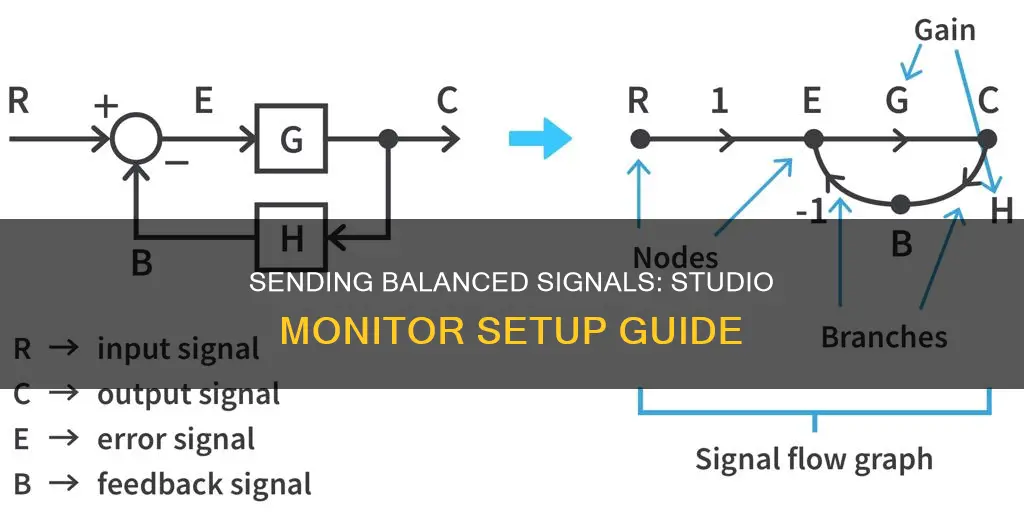
Studio monitors are speakers used by musicians to accurately listen back to their creations and make tweaks to get the perfect sound. When connecting studio monitors, it is important to use the correct cables to prevent interference from other electrical equipment, which can cause an annoying humming or buzzing sound.
Balanced cables are preferable to unbalanced cables when connecting studio monitors as they provide a signal that reduces unwanted noise and gives you a sound with less interference. Balanced cables have two signal wires that carry a copy of the signal, but with the polarity reversed. When the signal reaches the end of the cable, the two signals are flipped back, and the noise that was interfered with gets cancelled out.
To connect studio monitors, you should use balanced TRS or XLR mono cables. If your audio interface or console does not have a balanced output, you can use an unbalanced TS or RCA cable, but the signal will be more prone to noise interference.
| Characteristics | Values |
|---|---|
| Cable type | Balanced TRS or XLR mono cables |
| Cable type (alternative) | Unbalanced TS or RCA cable |
| Cable length (alternative) | Less than 5 feet |
| Signal type | Negative and positive |
| Signal type (alternative) | Positive only |
| Number of wires | Three |
| Number of connections | Two |
| Number of conductors | Three |
| Signal wires | Two |
| Ground wires | One |
| Cable connector | TRS (Tip Ring Sleeve) |
| Cable connector (alternative) | TS (Tip Sleeve) |
What You'll Learn

Balanced cables vs. unbalanced cables
The type of cable used in an audio system can have a significant impact on sound quality. Every cable has the potential to add noise and compromise the sound, so it is important to use the right cable for the right job.
Unbalanced Cables
An unbalanced cable consists of two connectors, with two conductors each, connected by two wires inside the cable—a signal wire and a ground wire. The signal wire is typically in the centre of the cable, with the ground wire surrounding it. The ground wire serves two functions: it carries part of the audio signal and shields the main signal wire from outside interference, such as hums from lights and transformers, as well as radio frequency interference.
However, the ground wire also acts like an antenna, picking up unwanted noise. Unbalanced cables are therefore best used for short distances, such as connecting a guitar to a nearby amp, to minimise the risk of unwanted noise.
Balanced Cables
Balanced cables, on the other hand, have three conductors in the connector and three wires in the cable: two signal wires plus a separate ground wire. Both signal wires carry a copy of the signal, but with the polarity reversed. When the two signals are combined at the end, the receiving equipment returns the second signal to its original polarity, so that the "good" signal is reinforced, while the noise is cancelled out.
Balanced cables are therefore better at eliminating noise and can support longer cable runs of 50 to 100 feet (15-30 metres).
Balanced vs Unbalanced Cables
It is important to note that using a balanced cable on an unbalanced signal will not improve the sound. The jacks on the equipment must be designed for balanced signals, otherwise, there is no circuitry to do the polarity inversion that produces noise cancellation. Using an unbalanced cable with gear that expects balanced signals will work, but the signal will be unbalanced and susceptible to noise.
Balanced cables tend to be priced higher than unbalanced cables due to having more parts, and the quality of the conductor and shielding.
Blind Spot Monitor: A Must-Have Feature for Jeep Renegade?
You may want to see also

Active speakers vs. passive speakers
The main difference between active and passive speakers is that active speakers have a built-in amplifier, while passive speakers require a connection to an external power amplifier. This distinction has several implications for the functionality and performance of the speakers.
Active speakers are often seen as a convenient, all-in-one system. The built-in amplifier simplifies the setup process and reduces the number of cables required, making it neater and potentially reducing interference. The amplifier and speaker are designed to work together, optimising sound quality and enhancing synergy. Active speakers also allow the signal to remain in digital form for longer, improving sound clarity. The amplifier and speaker components can be replaced if needed, and the system may be more reliable in providing consistent sound.
Passive speakers, on the other hand, offer more flexibility and customisation. Users can select and upgrade the amplifier to tailor the sound to their preferences. Passive speakers are generally less expensive upfront and lighter, making them suitable for wall mounting. They also use fewer power cables and extension cords.
Both types of speakers have their advantages, and the best option depends on the user's specific needs and preferences. Active speakers are ideal for those who prioritise convenience and simplicity, while passive speakers are better for those who want a customisable setup.
Now, let's take a closer look at the features of active and passive speakers and how they differ:
- Setup and Customisation: Active speakers are designed for a straightforward setup, with the amplifier and speaker integrated into a single unit. This simplifies the cabling process and reduces the risk of interference. Passive speakers, on the other hand, require an external amplifier, which adds complexity to the setup. However, this external amplifier gives users the flexibility to customise their sound system by pairing different amplifiers and speakers.
- Cost: Active speakers tend to be more expensive upfront due to the built-in amplifier. Passive speakers are usually less costly initially but may end up costing more in the long run due to the need for separate equipment, such as an external amplifier.
- Space: Active speakers save space since they do not require a separate amplifier. Passive speakers, however, require additional space for the external amplifier.
- Weight and Mounting: Passive speakers are typically lighter, making them suitable for wall mounting. Active speakers, on the other hand, can be too heavy for wall mounting and may require floor space.
- Power Cables: Passive speakers only need a speaker cable and are powered via the amplifier. Active speakers, on the other hand, require power cables and often need extension cords if there is no nearby power source or outlet.
- Sound Quality: Active speakers generally provide a more accurate frequency response and improved sound quality because the built-in amplifiers are specifically tuned for the drivers they power. Passive speakers can also deliver high-quality sound, but it depends on the compatibility between the external amplifier and the speakers.
- Repair and Upgrade Options: Active speakers cannot be easily upgraded or repaired since the components are integrated. If an issue occurs, you may need to replace the entire unit. Passive speakers, on the other hand, allow for individual components to be replaced or upgraded, such as the amplifier or speakers.
Removing the Stand: Acer LCD Monitor Disassembly Guide
You may want to see also

TRS and XLR cables
TRS (Tip, Ring, Sleeve) and XLR cables are the most common types of cables used to connect studio monitors to audio interfaces. Both cable types are balanced, which means they provide a cleaner sound with less interference than unbalanced cables.
TRS Cables
TRS cables have a 1/4" jack and are commonly used to connect studio monitors to audio interfaces because they are typically the only option available. They are also generally cheaper than XLR cables and just as effective at delivering a balanced signal.
XLR Cables
XLR cables are known for their strong connection and are often used to connect microphones or outboard audio equipment. They have locking clips, which can be useful in certain situations. XLR cables are also commonly used in live performances due to their sturdy connectors.
TRS vs. XLR
Both cable types deliver the same audio quality, and the choice between the two usually depends on the type of connectors available on your equipment. If your studio monitor and audio interface have different connector types, you can use a TRS-to-XLR cable to connect them.
It is important to ensure that you use balanced cables with your studio monitors to reduce unwanted noise and interference. Additionally, buying cables that are longer than you need can be helpful for future setups or upgrades.
Troubleshoot Vertical Lines on Your ASUS Monitor
You may want to see also

Cable length
The length of the cable you use can have a significant impact on the interference you experience with your studio monitors.
Unbalanced cables are more susceptible to interference, especially at longer lengths. The longer the cable, the more chance it has to act as an antenna for unwanted frequencies, picking up interference from static electricity or even radio transmissions.
If you are experiencing interference, switching to a balanced cable will likely reduce or eliminate the issue, even at longer lengths. Balanced cables are designed to eliminate noise and can carry stronger signals over longer distances, resulting in a higher signal-to-noise ratio and cleaner audio.
However, if you are using an unbalanced cable and are not experiencing any problems, there is no need to switch. Unbalanced cables are still a great option in many cases, especially when your connections don't support balanced cables or when using instruments like guitars that only support unbalanced signals.
Additionally, keeping unbalanced cables short can help minimise interference. If you are using an unbalanced cable, try to keep it under 15-20 feet in length to reduce the chances of picking up unwanted noise.
In summary, the length of the cable can affect the amount of interference in your studio setup. Balanced cables are ideal for longer distances, while shorter unbalanced cables can also work well if you're not experiencing any issues.
Disassembling LG Monitor: Removing EW244T Stand Safely
You may want to see also

Grounding
Understanding Grounding
In the context of studio monitors, grounding refers to the connection of the equipment to a common reference point, typically the earth. This connection is made through the ground wire, which is an essential component of audio cables. The ground wire serves two main purposes: preventing electrical hazards and minimising noise interference.
Safety First: Electrical Hazards
One of the primary functions of grounding is to protect users from electrical shocks and potential fires. By providing a path for electrical currents to flow to the earth, grounding ensures that stray voltages do not build up within the equipment. This is particularly important in the event of a fault or short circuit, as it helps prevent electric shock and protects the equipment from damage.
Reducing Noise Interference
In addition to safety, grounding plays a crucial role in reducing noise interference. Studio monitors are susceptible to picking up unwanted electrical noise from surrounding equipment, such as computers, power supplies, and even wall sockets. This noise can manifest as a hum or buzz, degrading the audio quality.
The ground wire acts as a shield, helping to minimise this interference. In unbalanced cables, the ground wire wraps around the signal wire, providing some protection. However, due to their design, unbalanced cables are more prone to picking up noise, especially when they are long.
Balanced Cables: The Superior Choice
Balanced cables offer a more effective solution to noise interference. They utilise a clever technique by incorporating a second signal wire. This additional wire carries an inverted version of the original signal, and when the two signals are combined, they cancel out any noise interference through a process known as "phase cancellation". As a result, the unwanted noise is silenced, ensuring a cleaner and more accurate audio signal.
To ensure optimal performance and safety, it is essential to follow best practices when grounding studio monitors:
- Use balanced cables whenever possible, especially in noisy environments or when using longer cable runs.
- Keep unbalanced cables as short as possible to minimise the risk of noise interference.
- Ensure proper grounding of all connected equipment, including computers, audio interfaces, and power supplies.
- Utilise professional-grade cables from reputable manufacturers to ensure optimal performance and safety.
- Consult the user manuals for your specific equipment to understand their unique grounding requirements and connection types.
By following these guidelines, you can effectively ground your studio monitors, resulting in improved audio quality and a safer working environment.
Evading Ankle Monitors: Strategies for Circumventing Homeguard Surveillance
You may want to see also
Frequently asked questions
Balanced cables provide a signal that reduces unwanted noise, giving you a sound with less interference, which is important when monitoring. They have three wires and three conductors: two signal wires and a separate ground wire. The two signal wires carry a copy of the signal, but with their polarity reversed. This means that any noise interference is also reversed in polarity, and when the signal is flipped back at the output end, the noise is cancelled out.
Unbalanced cables carry only the positive audio signal and the ground. They have two separate connections, one for a signal wire and one for a ground wire, and can be identified by their connectors, as each wire has its own contact point. The ground wire acts as a shield to prevent interference from outside sources, but it can also act as an antenna and pick up noise, especially if the cable is long.
All XLR to XLR cables are balanced. For 1/4 jacks and 1/8 jacks, a balanced cable will have two rings (known as TRS - Tip Ring Sleeve), whereas an unbalanced cable will have one ring (known as TS - Tip Sleeve). RCA cables are unbalanced.







